Location in
Google map
The temple
Prathishta
The
Vahanas
Temple tank
|
  |
Gosripuram Cochin
Tirumala Devaswom is the biggest and most important socio-religious institution of Gowda
Saraswat Brahmins of Kerala. The temple is situated at Cherlai in the heart of
Mattancherry town in Cochin area which is one of the earliest settlements of GSBs in
Kerala. The temple was established in the later half of 16th century. The history of GSBs in Kerala is inter-woven with that of this temple and
its Venkatewara idol.
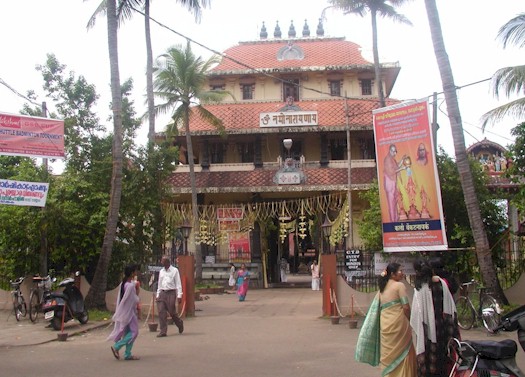
Temple main gopuram
Prathista
 The prathista is on a five
layered throne. The main idol of Venkateswara, his consorts, Sreedevi and Bhoodevi on
either side is situated at the top of the throne, Utsava Murti with consorts in the middle
and Utsava Lakshmi at the lower layer. On the lowest layer are the Salagramas. The prathista is on a five
layered throne. The main idol of Venkateswara, his consorts, Sreedevi and Bhoodevi on
either side is situated at the top of the throne, Utsava Murti with consorts in the middle
and Utsava Lakshmi at the lower layer. On the lowest layer are the Salagramas.
There are four sub temples or shrines
inside the main temple premises, dedicated to Goddess Mahalakshmi, Hanuman, Garuda and
Vigneswara. The Brindavan of Swami Sukritindra Tirta is also loacted here. A Naga Yakshi
pedestal is situated on the southwest corner of the main temple next to the Vighneswara
shrine. On Naga Panchami day Abhishekam of tender coconut is performed to this granite
idol. Devotees light oil lamp here for warding off evil and freedom from fear.
The Venkatewara idol
The Idol of Lord Venkatesvara being worshipped at
Cochin Tirumala Devaswom temple was obtained from Swami Vijayindra Tirtha of Sree
Kumbhakonam Mutt in exchange of a heap of gold coins which would immerse the idol. Three
pratishthas (Consecrations) of the idol has taken place at this temple in the last four
hundred years. It is believed that the area where this divine idol resides, will have 20
pounds of gold daily (or prosperity equivalent to that).
Story of the idol
During
15th Century AD, the Vijayanagar Kingdom was ruled by a pious king Saluva Narasimha
Raya, one of the popular royal dynasties of ancient India. This king was an ardent
devotee of Lord Venkateswara of Tirupati and used to visit the temple by walking up the
hill for worship. When the king became old and physically incapable to walk, he prayed the
Lord to see him daily.
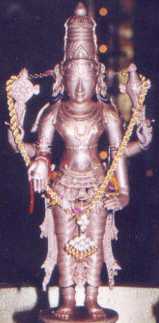 One
day a sculptor appeared before him and agreed to make an idol of the Lord for his daily
worship. The king gave the sculptor the required materials for making the idol and the
sculptor shut himself up in a room. As he did not come out of the room even after a
reasonably long period, the room was broken open only to see the idol of the Lord; the
sculptor missing. It is believed that the Lord himself came as the sculptor and the idol
is considered as Swayambhu or self born. The king built a temple for the idol and he was
instructed by the Lord in his dreams to consecrate the idol during the auspicious time,
when the heavenly drums dundubhi would be heard. As fate would have it, some crows
happened to fly over the royal drums with twigs in their beaks and the twigs accidentally
dropped on the drums producing a sound, which was mistaken for the auspicious hour
indicated by the Lord. The idol was duly consecrated at that hour which was
inauspicious.The grief stricken king was pacified by the Lord in his dream that He would
remain with him till his death, after which he would leave for a place by name Gosripuram.
After the demise of the king, a great fire broke out in the kingdom and the idol was
thrown into a dilapidated well. As the legend has it, Swami Vijayindra Tirtha of Sree
Kumbhakonam Mutt who happened to traverse that region during one of his tours, is said to
have been led by a serpent to the well wherein the idol of the Lord was deposited. The
Swamiji recovered the idol from the well and started worshipping the idol along with his
other idols. Swami Vijayindra Tirtha visited Cochin and performed Chaturmasa Vrita
among the Gauda Saraswat Brahmin Community of Cochin. Upon seeing the radiance of the
idol, the community of Cochin under the leadership of Sri Mala Pai, requested the idol
from the Swamiji. One
day a sculptor appeared before him and agreed to make an idol of the Lord for his daily
worship. The king gave the sculptor the required materials for making the idol and the
sculptor shut himself up in a room. As he did not come out of the room even after a
reasonably long period, the room was broken open only to see the idol of the Lord; the
sculptor missing. It is believed that the Lord himself came as the sculptor and the idol
is considered as Swayambhu or self born. The king built a temple for the idol and he was
instructed by the Lord in his dreams to consecrate the idol during the auspicious time,
when the heavenly drums dundubhi would be heard. As fate would have it, some crows
happened to fly over the royal drums with twigs in their beaks and the twigs accidentally
dropped on the drums producing a sound, which was mistaken for the auspicious hour
indicated by the Lord. The idol was duly consecrated at that hour which was
inauspicious.The grief stricken king was pacified by the Lord in his dream that He would
remain with him till his death, after which he would leave for a place by name Gosripuram.
After the demise of the king, a great fire broke out in the kingdom and the idol was
thrown into a dilapidated well. As the legend has it, Swami Vijayindra Tirtha of Sree
Kumbhakonam Mutt who happened to traverse that region during one of his tours, is said to
have been led by a serpent to the well wherein the idol of the Lord was deposited. The
Swamiji recovered the idol from the well and started worshipping the idol along with his
other idols. Swami Vijayindra Tirtha visited Cochin and performed Chaturmasa Vrita
among the Gauda Saraswat Brahmin Community of Cochin. Upon seeing the radiance of the
idol, the community of Cochin under the leadership of Sri Mala Pai, requested the idol
from the Swamiji.
The Swamiji agreed to hand over the idol in exchange for a
heap of gold coins that would immerse the idol. All the gold coins brought in by the
wealthy Mala Pai could cover only the body of the idol and not its tip. It was presumed
that the Lord did not want to stay at cochin as a property of an individual. Only gold
coins and ornaments brought in from the home of every community member could cover the tip
of the idol. Kanakabishekam, a symbolic ritual of this immersion of the idol in gold is
performed to the Lord even to this day during any special occasion.
|
The First Pratishtha
was performed by Swami Sudheendra Tirtha, the disciple of Swami Vijayindra Tirtha in the
year 1599 AD.
Second Pratishtha
During the second half of the 17 Century AD the
Dutch made an unsuccessful attempt to capture the Fort at Cochin from the Portuguese. The
Konkanis who rendered assistance to the Dutch were tortured by the Portuguese and their
houses, markets and temple known as Cochin Tirumala Devaswom were plundered. The Konkanis
had to flee from Cochin to a place called Udayamperur. But later on when the Portuguese
surrendered to the Dutch, the Konkanis resettled at Cochin and reconstructed the temple.
The second Prathistha of Lord Venkatesvara was performed in the reconstructed temple at
Cochin during the year 1719 AD. The consecration took place at the hands of Swami Devendra
Tirtha, the sixth pontiff of Sree Kashi Mutt Samsthan.
Third Pratishtha
Later half of 18th Century marked the terrible
persecution of the Konkanis at the hands of Raja Rama Varma, popularly known as Sakthan
Thampuran and the temple too was looted. The persecuted konkanis fled southwards to
Alleppey in the Travancore region along with the idol of the Lord Venkatesvara. They were
allowed to settle at Alleppey and install their idol in a temple there near the Alleppey
canal with an assurance to bring about their return to Cochin once better atmosphere
prevailed. Alleppey prospered as a busines centre during the stay of Konkanis there and
the prosperity was attributed to the power of Lord Venkatesvara installed there. After the
death of Shakthan Thampuran, the raja who succeeded him took keen interest to get back the
idol of Lord Venkatesvara to Cochin. Their repeated requests were turned down. The
desperate Konkanis had to ultimately steal the idol from Alleppy. As it was found that the
Raja of Cochin too was involved in this robbery, fierce legal battle followed for decades
between the Raja of Cochin and Travancore and in the end the GSB community of Cochin won
the case. The idol of the Lord was consecrated for the third time at the renovated temple
in 1881 AD. The four sub temples inside the main temple premises, dedicated to Goddess
Mahalakshmi, Hanuman, Garuda and Vigneswara were built during this period. The Pratishtha
took place at the hands of Swami Bhuvanendra Tirtha, the 17th pontiff of Sree
Kashi Mutt Samsthan along with his disciple Swami Varadendra Tirtha.
The temple
 The
temple is situated in a vast area of 5 ½ acres. The Coconut Palm grove all around
the temple area gives it a panoramic look. There is a broad pathway around the temple
outskirts. On the north east corner is the Papanasam temple tank. The revolving
cradle in the upper storey of the copper roofed Mani Mantapam in the centre of the tank is
an excellent piece of temple art noted for wood work and engineering skill. The
temple is situated in a vast area of 5 ½ acres. The Coconut Palm grove all around
the temple area gives it a panoramic look. There is a broad pathway around the temple
outskirts. On the north east corner is the Papanasam temple tank. The revolving
cradle in the upper storey of the copper roofed Mani Mantapam in the centre of the tank is
an excellent piece of temple art noted for wood work and engineering skill.
Chakrasnanam is conducted here twice a year
during the eighth day of temple festivals. There are two Aratu festivals which falls in
the months of Vrichigam and Meenam with a duration of 8 days.
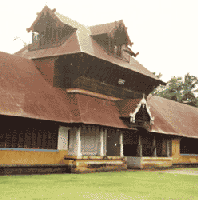
Northern gopuram
|

Southern gate
|
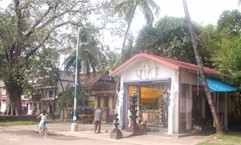
The Dharma Sastha temple across the road at the backside of temple.
The Althara is seen at the left.
|
The Pagoda type two storeyed Northern Gopuram and seventy feet high
three storeyed Vimana shaped Eastern Gopuram are works of marvel. Beautiful paintings by
indigenous craftsmen depicting various scenes from the Puranas and epics adorn the ceiling
of the northern gopuram.
In the outer most periphery of the complex is
housed the Sukratindra Sadan, the Bungalow for the Swamiji to camp during his visits,
Saraswati Nilayam, which houses the Temple Library, Santhi Kulam, the bathing tank for
temple priests, Dove cot, Mini Garden, Elephant Shed, Gosala, vast Agrasalas, Stores,
Yogasala, Treasury, Vessel Store, Main Office, Veda Patasala, Vyasa Mandir,
Vahanas-Gallery, Vimana House, Washing Tank, huge Uootupura, & Main Flower Garden. The
next Prakara is wide open ground for Sheeveli and Vahana Pooja . Adjacent to it is Kalyana
Utsavav pathway through which the Festival deities are taken in Palanquin in a procession
before and after Kalyanotsavam. |
|
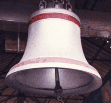
The bronze bell
4ft dia and 6ft high
is the 2nd largest
bronze bell in Asia |
The temple is governed by the the Cochin Tirumala Devaswom.
Temple tank & Chakra snanam
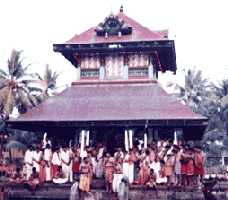
Arattumandapam

To Arattumandapam in boat
|
The temple tank or PadmaTirtham
is outside the temple main gopuram on the north-east corner and has the
Arattumandapam at its center.
On the eighth and final day of Aratt (annual
festival) the Lord is taken in the gold palanquin in a procession to the temple tank. The
Lord is taken round the tank in a canoe specially decorated for the occasion. Chakra
Snanam or immersion of the Sudarshana Chakra along with the Salagrama in the tank is
performed here. The Lord along with his consorts is seated on a revolving cradle on the
first floor of the Arattumandapam. Later in the night, the Lord seated in golden palanquin
complete proceeds in a royal procession to the temple to the accompaniment of
Panchavadyam.
A special event of this evening is that when the
procession just comes out of the Arattumandapam, the Arati is offered to the Lord on
behalf of king Saluva Narasimha Raya, the king for whom this Lord appeared as Swayambhu
and also on behalf of Swami Vijayindra Tirtha, the Swamiji who brought the idol to Cochin.
The idols of these two personalities are
installed at the entrance of the Arattumandapam. |
courtesy: www.gosripuram.org
|
